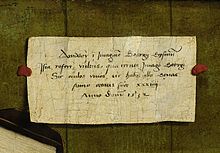

A cartellino (Italian for "small piece of paper"[1]) is an illusionistic portrayal of a written note included in painting, mostly from the with a legend that records the name of the artist, the date, the subject, or some other relevant information about the work. About 500 Renaissance paintings include a cartellino, but the device has been adopted by some later artists.
It usually takes the form of a fictive rectangular scrap of parchment or paper – sometimes with frayed edges, creased or torn – which is depicted as being attached with a pin or wax to a surface that lies parallel to the picture plane, perhaps a foreground parapet or a background wall. Often the cartellino gives the impression of the note being attached to the surface of the painting rather than being part of the artwork itself.
This trompe-l'œil effect may reflect an earlier artistic practice of real notes being physically attached to paintings. Other suggestions of the origins include the inscriptions included in the Early Netherlandish paintings works of Jan van Eyck, such as his 1432 Léal Souvenir, and from the artistic practice at the studio of Francesco Squarcione in Padua, based on the gothic inscriptions seen in medieval paintings.
- ^ In modern Italian, carta means "paper", the diminutive cartello means "sign", and the double diminutive cartellino means "tag".